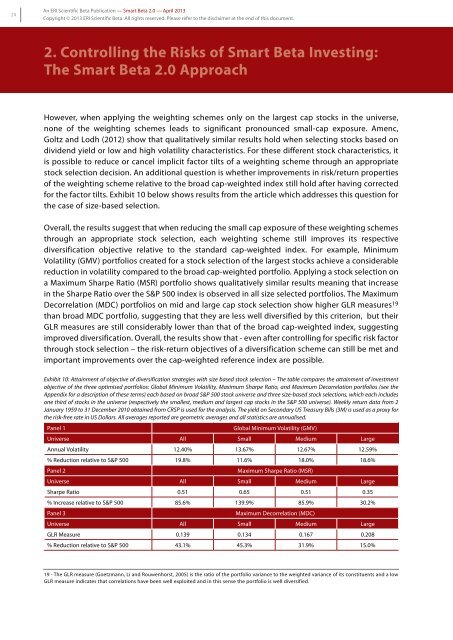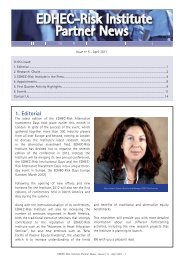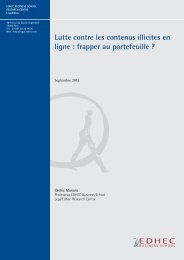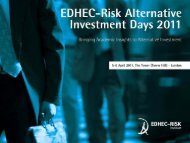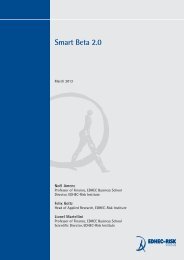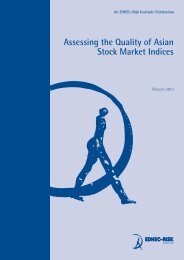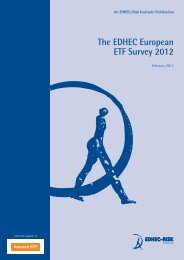The Smart Beta 2.0 Approach - EDHEC-Risk
The Smart Beta 2.0 Approach - EDHEC-Risk
The Smart Beta 2.0 Approach - EDHEC-Risk
Create successful ePaper yourself
Turn your PDF publications into a flip-book with our unique Google optimized e-Paper software.
24<br />
An ERI Scientific <strong>Beta</strong> Publication — <strong>Smart</strong> <strong>Beta</strong> <strong>2.0</strong> — April 2013<br />
Copyright © 2013 ERI Scientific <strong>Beta</strong>. All rights reserved. Please refer to the disclaimer at the end of this document.<br />
2. Controlling the <strong>Risk</strong>s of <strong>Smart</strong> <strong>Beta</strong> Investing:<br />
<strong>The</strong> <strong>Smart</strong> <strong>Beta</strong> <strong>2.0</strong> <strong>Approach</strong><br />
However, when applying the weighting schemes only on the largest cap stocks in the universe,<br />
none of the weighting schemes leads to significant pronounced small-cap exposure. Amenc,<br />
Goltz and Lodh (2012) show that qualitatively similar results hold when selecting stocks based on<br />
dividend yield or low and high volatility characteristics. For these different stock characteristics, it<br />
is possible to reduce or cancel implicit factor tilts of a weighting scheme through an appropriate<br />
stock selection decision. An additional question is whether improvements in risk/return properties<br />
of the weighting scheme relative to the broad cap-weighted index still hold after having corrected<br />
for the factor tilts. Exhibit 10 below shows results from the article which addresses this question for<br />
the case of size-based selection.<br />
Overall, the results suggest that when reducing the small cap exposure of these weighting schemes<br />
through an appropriate stock selection, each weighting scheme still improves its respective<br />
diversification objective relative to the standard cap-weighted index. For example, Minimum<br />
Volatility (GMV) portfolios created for a stock selection of the largest stocks achieve a considerable<br />
reduction in volatility compared to the broad cap-weighted portfolio. Applying a stock selection on<br />
a Maximum Sharpe Ratio (MSR) portfolio shows qualitatively similar results meaning that increase<br />
in the Sharpe Ratio over the S&P 500 index is observed in all size selected portfolios. <strong>The</strong> Maximum<br />
Decorrelation (MDC) portfolios on mid and large cap stock selection show higher GLR measures 19<br />
than broad MDC portfolio, suggesting that they are less well diversified by this criterion, but their<br />
GLR measures are still considerably lower than that of the broad cap-weighted index, suggesting<br />
improved diversification. Overall, the results show that - even after controlling for specific risk factor<br />
through stock selection – the risk-return objectives of a diversification scheme can still be met and<br />
important improvements over the cap-weighted reference index are possible.<br />
Exhibit 10: Attainment of objective of diversification strategies with size based stock selection – <strong>The</strong> table compares the attainment of investment<br />
objective of the three optimised portfolios: Global Minimum Volatility, Maximum Sharpe Ratio, and Maximum Decorrelation portfolios (see the<br />
Appendix for a description of these terms) each based on broad S&P 500 stock universe and three size-based stock selections, which each includes<br />
one third of stocks in the universe (respectively the smallest, medium and largest cap stocks in the S&P 500 universe). Weekly return data from 2<br />
January 1959 to 31 December 2010 obtained from CRSP is used for the analysis. <strong>The</strong> yield on Secondary US Treasury Bills (3M) is used as a proxy for<br />
the risk-free rate in US Dollars. All averages reported are geometric averages and all statistics are annualised.<br />
Panel 1<br />
Global Minimum Volatility (GMV)<br />
Universe All Small Medium Large<br />
Annual Volatility 12.40% 13.67% 12.67% 12.59%<br />
% Reduction relative to S&P 500 19.8% 11.6% 18.0% 18.6%<br />
Panel 2<br />
Maximum Sharpe Ratio (MSR)<br />
Universe All Small Medium Large<br />
Sharpe Ratio 0.51 0.65 0.51 0.35<br />
% Increase relative to S&P 500 85.6% 139.9% 85.9% 30.2%<br />
Panel 3<br />
Maximum Decorrelation (MDC)<br />
Universe All Small Medium Large<br />
GLR Measure 0.139 0.134 0.167 0.208<br />
% Reduction relative to S&P 500 43.1% 45.3% 31.9% 15.0%<br />
19 - <strong>The</strong> GLR measure (Goetzmann, Li and Rouwenhorst, 2005) is the ratio of the portfolio variance to the weighted variance of its constituents and a low<br />
GLR measure indicates that correlations have been well exploited and in this sense the portfolio is well diversified.


